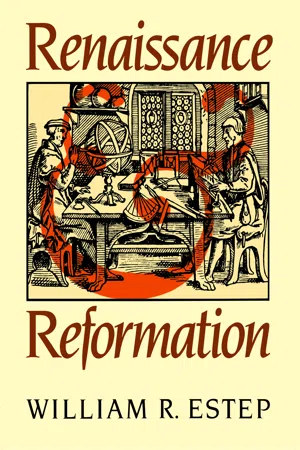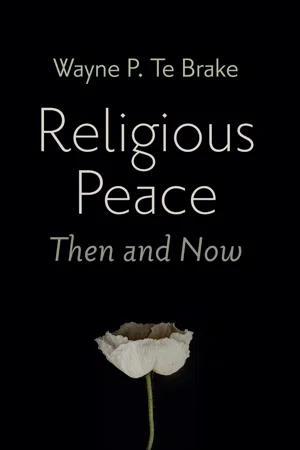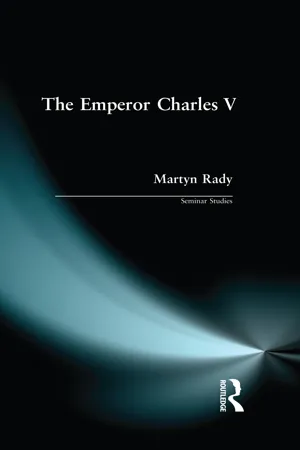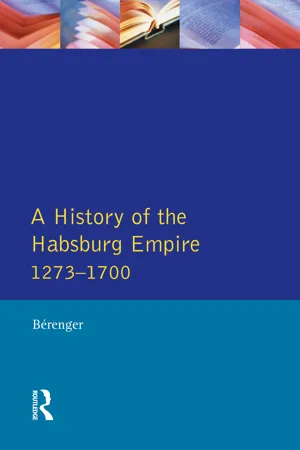History
Schmalkaldic War
The Schmalkaldic War was a conflict in 16th-century Germany between the Holy Roman Emperor Charles V and the Schmalkaldic League, a coalition of Protestant states. The war was primarily a result of religious tensions between Catholics and Protestants, and it ended with the defeat of the Schmalkaldic League at the Battle of Mühlberg in 1547, leading to increased centralization of power by the emperor.
Written by Perlego with AI-assistance
Related key terms
5 Key excerpts on "Schmalkaldic War"
- eBook - ePub
- William R. Estep(Author)
- 1986(Publication Date)
- Eerdmans(Publisher)
Chapter XVICONFLICT AND CHANGE
D uring the eighteen-year span of the Council of Trent, the religious configuration of Northern Europe was undergoing a rapid change. An occasional setback notwithstanding, the march of Protestantism in the Holy Roman Empire seemed irresistible. When Albert of Mainz died in September 1545, he was succeeded by one who owed his office to the support of Protestant princes, whom he soon repaid by opening his territory to evangelical preaching. He also permitted clerical marriage and communion in both kinds. The elector of the Palatinate also received communion in both kinds in January 1546 and joined the Schmalkaldic League, a military alliance made up of Lutheran territories and cities. Consequently, by the outbreak of the Schmalkaldic War, the majority of the electors of the Holy Roman Empire were casting their lots with the Protestants.CHARLES V AND THE Schmalkaldic WarAfter still another conference at Regensburg failed to achieve reconciliation between Protestants and Catholics, the emperor decided to resort to arms. In July he denounced as outlaws Landgrave Philip of Hesse, Elector John Frederick of Saxony, and the leaders of the Schmalkaldic League. Charles V was now surer than ever of a military victory over the German princes because of the defection of Maurice of Saxony. Maurice had a sizable army and ambition to match. He allied himself with Charles V in the hopes of defeating the Schmalkaldic League and gaining for himself John Frederick’s position as elector. In a very short time he overran the land and with the aid of the emperor and his Spanish army secured the coveted position for himself. He was made elector in October 1546. John Frederick was defeated by Charles and his army at Mühlberg and taken captive on April 24, 1547. Philip of Hesse, Maurice’s father-in-law, surrendered to the emperor at Halle on June 19 and was imprisoned. The archbishop elector of Cologne was forced to retire to his ancestral estate. Spanish troops occupied every major Protestant center in Germany. Thus the Schmalkaldic League was destroyed and with it Lutheran religious life and political influence in much of Germany. - eBook - ePub
- Wayne P. Te Brake(Author)
- 2022(Publication Date)
- Cascade Books(Publisher)
125 years.The Kappel Wars lack the scale and drama, not to mention the monumental destruction of human life, of modern warfare, or even the infamous German Peasants’ War, which had preceded them by just a few years. Still, this small Swiss beginning illustrates how quickly politically salient religious identities could be activated in a specific setting and, in combination with political polarization that undermined collaboration, and escalation via networks of religious solidarity as well as the brokerage of broader alliances, make religious war possible. The same mechanisms combined to produce religious war in the Holy Roman Empire, the Swiss Confederation’s much larger neighbor to the north, only in this case the process moved much more slowly.The Schmalkaldic Wars in Germany, like the Kappel Wars in Switzerland, were predicated on the success of religious reform efforts at the local and territorial level. For example, in the territory of Saxony, where Martin Luther enjoyed official protection following the condemnation of his new theology by the Imperial Diet in 1521 , Luther himself helped to construct a new model of the Christian community. Meanwhile, in a large majority of the Empire’s eighty self-governing Imperial Free Cities, as well as in many of the Empire’s two-thousand provincial cities, popular reform movements helped to propel the religious pluralization process on a much broader scale. The Emperor, Charles V, remained steadfastly opposed to religious reform, and in alliance with the important Prince-Bishops of Cologne and Mainz, as well as the Dukes of Bavaria, headed the Imperial opposition to reform. Political polarization recurrently paralyzed the Imperial Estates, while escalation via organized networks of religious solidarity and political brokerage combined to produce the Evangelical League of Schmalkalden, which gave its name to the first rounds of religious war in Germany. Still, the emperor and his Evangelical opponents recurrently overcame their religious differences in order to collaborate in opposition to the military advance of the Islamic Ottoman Empire in the East or to crush the “radical” religious revolutionaries who took over the city of Münster in the 1530 - eBook - ePub
- Martyn Rady(Author)
- 2014(Publication Date)
- Routledge(Publisher)
doc. 17 ].Up to this point, we have stressed religious conviction as the driving force behind Charles's decision to go to war. This is the traditional approach of his biographers and one which Charles in his memoirs certainly leads us to accept. Nevertheless, recent research suggests that a secular and dynastic motivation also inspired Charles's resolve. In particular, attention has been drawn to the growing threat which the Schmalkaldic League posed to Charles's possessions in the north-west and to how developments in this region were linked with the continuing religious crisis in the Empire (91 , 118 ).Although historical atlases usually colour Westphalia in a blue wash denoting 'ecclesiastical possessions', this land should properly be shown as a rainbow of principalities as confused and varied as Swabia and Franconia. Over the preceding half-century, the Habsburgs, from the Netherlands, and the Landgraves of Hesse had been penetrating into this area. The latter took particular advantage of the vacuum left by the extinction in 1479 of the Katzenen bogeln family, whose chocolate-box castles still command the heights of the middle Rhine. Nevertheless, the rivalry between the Habsburgs and Hesse was at this stage a friendly one and the Landgrave Philip readily assisted Charles in his local war against the bishopric of Hildesheim. But with the Landgrave's conversion to Lutheranism in 1524, territorial politics became embittered by religious differences. Philip's allies in the Schmalkaldic League urged him on towards the heart of Westphalia: the bishoprics of Miinster, Minden, Paderborn and Osnabriick. Within only a short time, by 1532, these had passed to Bishop Franz von Waldeck, one of Philip's relatives. This was an area of tremendous strategic importance: to the north lay Bremen and Verden, the gateway to Denmark; and to the south and west, beyond Miinster and Osnabrück, were the great electoral dioceses of Cologne and Trier and, more especially, the Netherlands. - eBook - ePub
- Jean Berenger, C.A. Simpson(Authors)
- 2014(Publication Date)
- Routledge(Publisher)
The European chancelleries continued to be preoccupied with Spanish imperialism even after the appeasement at the beginning of the century and the Franco-Spanish agreement sketched out under Henry IV, marked by the double marriage of Anne of Austria to Louis XIII and Elizabeth of Bourbon to Philip IV. The Madrid Habsburgs were not resigned to the final partition of the Netherlands of Charles V. The work of Michel Devèze and of Spanish historians has done justice to the legend of 'Spanish decadence' around 1620. Yet, despite Philip II's failures and the rise of Holland, Spain remained a power to be feared and was given a new impulse by Olivares, Philip IV's prime minister. The conflict, however, was born in the Empire where antagonism among Catholics, Lutherans and the Reformed Church grew worse since the Peace of Augsburg (1555) had given rise to much contention aggravated by the advance of the Counter-Reformation.The parties had been trying to organize themselves since 1608. Some Protestant princes had formed the Evangelical Union, but the Lutherans and the Reformed hated each other heartily and had been unable to come together. The electors of Saxony and Brandenburg, out of loyalty to the emperor, had refused to form a party and the elector Palatine, who was a Calvinist, had assumed leadership of the Union with the encouragement of Christian I of Anhalt. The Catholics responded in 1609 by founding the Catholic League, which from the beginning was led by the duke of Bavaria. Both parties, then, had a Wittelsbach as leader. The Holy League united most of the ecclesiastical princes of southern Germany, in particular the archbishop-electors of Trier, Mainz and Cologne.The affair of the Jülich succession set the two parties face-to-face and would have ended in open warfare had it not been for the assassination of the king of France, Henry IV, who was preparing to invade Germany in May 1610 to aid his Protestant allies. Eight years later, the political crisis in Bohemia provided the occasion for war.The Political Crisis in Bohemia 3
Following the Defenestration, the dispute grew worse as before long there rose the question of the limits set to the Letter of Majesty. The confessional dispute grew into a rebellion. The nobles with count Thurn at their head rebelled once they understood that Ferdinand of Styria was determined to govern and that he was a supporter of absolutism: had he not taken as his motto Princeps debet esse nulli subjectus - eBook - ePub
Self-Defence and Religious Strife in Early Modern Europe
England and Germany, 1530–1680
- Robert von Friedeburg(Author)
- 2017(Publication Date)
- Routledge(Publisher)
32 it must not be overlooked that the magistrates of this town - similar to the magistrates of other towns like Rostock and Magdeburg - had not yet accepted their future status as subjects of territorial lords and still struggled to defend their independence. The issue was thus not necessarily one of freedom struggling against oppression, but of many different degrees of citizens of the Empire struggling to improve their own status by simultaneously insisting on the inferiority of their own subjects and servants - as we shall see later in the case of Magdeburg. It must not be overlooked that such politics remained very much within the traditional scope of princely politics in the Empire and that all the princes simultaneously tried to control their own vassals and towns, just as urban magistrates attempted to enforce obedience toward their fellow citizens.Despite this traditional outlook of the tools used, the situation differed due to the issue it was fought about - religion. This was an issue entirely different from the familiar feuds for influence and possessions in the Empire or even from the deposition of Emperor Wenzel. Even if Charles had wanted to, he could not, as a faithful Christian, allow heretics to administer their errors in the Empire. Moreover, since the advent of the Reformation, it had become a public event popularised by cheap popular print. Conflicts among common men and among urban and regional secular and ecclesiastical authorities did not terminate in 1530. Rather, they continued. In the years to come, the league and its argument on defence was going to be extended by a wave of popular broadsheets, making available to the public the reasoning of the league, underpinned by Luther's authority, but at the same time allowing other authors to try and influence the debate by their own publications. During the struggle for public opinion in the years between 1530 and the outbreak of the Smalcaldic War, the shape of the argument about legitimate defence by the princes was severely changed by a number of such pamphlets. To pin down these changes we will have to look at pamphlets other than those written by the Wittenberg theologians. We will concentrate, however, on those broadsheets deemed to be important enough to be included in the influential edition of such texts by the Saxon lawyer Friedrich Hortleder on the eve of the Thirty Years War, in 1618.
Index pages curate the most relevant extracts from our library of academic textbooks. They’ve been created using an in-house natural language model (NLM), each adding context and meaning to key research topics.




